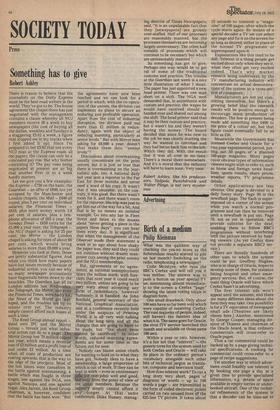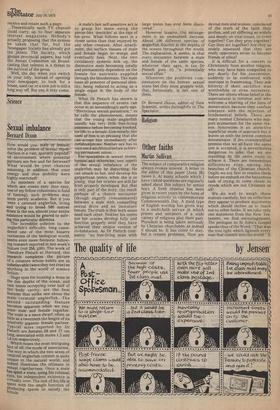Advertising
Birth of a medium
Philip Kleinman
What was the quickest way of checking the yes-no score as the Referendum results started to pile up last month?. Switching on the radio, telephoning a newspaper?
Colin McIntyre, who runs the BBC's Ceefax unit will tell you it was neither. The answer was to push a button on your special TV set, summoning almost immediate ly to the screen a Ceefax "page" showing the latest voting totals in diagram form. One small drawback. Only about 100 sets have so far been sold which were capable of receiving Ceefax. The vast majority of people, indeed, still haven't the faintest idea of what it is. The same goes for Oracle, the rival ITV service launched this month and available on those same 100 sets.
Within a year or two, however, it's a fair bet that "teletext" — the generic term for the system used by both Ceefax and Oracle — will take its place in the ordinary person's vocabulary alongside such other bits of technical jargon as transistor, computer and television itself.
How does teletext work? To cut a long story very short, pages of diagrams or words — up to 100 words a page — are transmitted in the form of coded electronic pulses carried on two unused lines of the 625-line TV picture. It takes about
15 seconds to transmit a -magazine" of 100 pages, after which .the cycle starts again. By means of a
special decoder a TV set can select any page and fix it on the screen for as long as desired, either in place of the normal TV programme or superimposed upon it.
Explanations like this tend to be dull. Teletext is a thing people get excited about only when they see it, when they often get very excited indeed. That's why market research being undertaken by the TV manufacturing industry will concentrate on actual demonstrations of the system to a cross-section of consumers.
Manufacturers are not yet committing themselves, but there's a growing belief that the research results will be positive enough to encourage mass production of decoders. The few at present being made add something like £400 to the price of a colour set, but that figure could eventually fall to as little as £30.
Meanwhile the Government has lieensed Ceefax and Oracle for a
twolyear experimental period, put
ting. out. 50 pages of a planned 100-page magazine. Many pages cover obvious types of information viewers might wish to refer to, such as home and foreign news head lines, sports results, share prices, weather reports, TV programme details.
Other applications are less obvious. One page is devoted to a daily funny story. Page 50 is the newsflash page. The flash is superimposed on a corner of the screen while you watch a normal pro gramme and can then be removed until a newsflash is put out. Page 70, not as yet in operation, will provide subtitles for the deaf, enabling them to follow BBC1 programmes without interfering with the picture received by hearing viewers. (As yet Ceefax does not provide a separate BBC2 service.) There are literally hundreds of other uses to which the system could be put. Geoffrey Hughes, who is in charge of Oracle, hopes to develop some of them, for instance listing hospital and other emergency services. But, of course, the main thing Oracle will have which Ceefax hasn't is advertising.
The first teletext ads won't appear until the autumn, and there are many different ideas about the form they may take. One possibility is for a TV equivalent of newspaper small ads (Theatres are likely clients here.) Another, mentioned by George Cooper, managing dir ector of Thames and chairman of the Oracle board, is that ordinary commercials will cross-refer to Oracle pages.
Thus a car commercial could be backed up by a page giving techni cal specifications. A cooking fat commercial could cross-refer to a page of recipe suggestions.
Yet another way in which advertisers could feasibly use teletext is by booking one page a day at a given time to provide specialised information, e.g. details of space available in empty lorries or underbooked aircraft. One of the technical refinements of the system is that a decoder can be time-set to receive and retain such a page.
Theoretically each TV channel could carry up to four separate teletext magazines. Nobody's actually proposing that the system be taken that far, but the Newspaper Society has already got the jitters. The Society, which groups provincial papers, has told' the Annan Committee on Broadcasting that teletext is a threat to the survival of the press.
Well, the day when you switch on your telly, instead of opening your newspaper, to look for a house, used car or a new job is still a long way off. But yes, it may come.
)111.moonnioniailiiiifet11111111r.



































 Previous page
Previous page